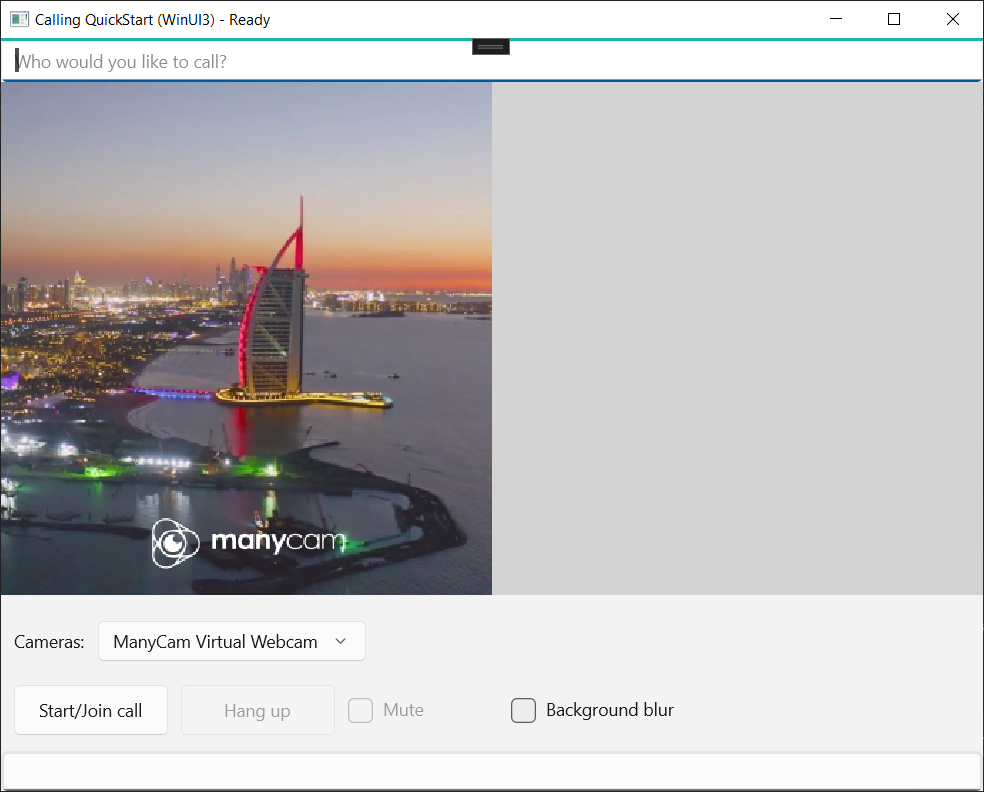使用通訊服務的通話 SDK,在應用程式中新增 1 對 1 音訊和視訊通話,以開始使用 Azure 通訊服務。 您將了解如何使用適用於 JavaScript 的 Azure 通訊服務通話 SDK,開始並接聽通話。
範例程式碼
如果您想要直接跳到結尾,您可以在 GitHub \(英文\) 上下載此快速入門作為範例。
必要條件
- 取得具備有效訂用帳戶的 Azure 帳戶。 免費建立帳戶。
- 您必須具有 Node.js 18。 您可以使用 msi 安裝程式進行安裝。
- 建立作用中的通訊服務資源。 建立通訊服務資源。
- 建立使用者存取權杖來將通話用戶端具現化。 了解如何建立和管理使用者存取權杖。
- 使用 Graph 總管取得 Teams 執行緒識別碼來進行通話作業。 深入了解如何建立聊天對話識別碼。
設定
建立新的 Node.js 應用程式
開啟您的終端機或命令視窗,為您的應用程式建立新的目錄,並瀏覽至該目錄。
mkdir calling-quickstart && cd calling-quickstart
執行 npm init -y 以使用預設設定建立 package.json 檔案。
npm init -y
Install the package
使用 npm install 命令,以安裝適用於 JavaScript 的 Azure 通訊服務通話 SDK。
重要
本快速入門會使用最新 Azure 通訊服務通話 SDK 版本。
npm install @azure/communication-common --save
npm install @azure/communication-calling --save
設定應用程式架構
本快速入門會使用 webpack 來組合應用程式資產。 執行下列命令以安裝 webpack、webpack-cli 和 webpack-dev-server npm 套件,並將其列為 package.json 中的開發相依性:
npm install copy-webpack-plugin@^11.0.0 webpack@^5.88.2 webpack-cli@^5.1.4 webpack-dev-server@^4.15.1 --save-dev
在專案的根目錄中建立 index.html 檔案。 我們將使用此檔案來設定基本配置,讓使用者能夠撥打 1 對 1 視訊通話。
程式碼如下:
<!-- index.html -->
<!DOCTYPE html>
<html>
<head>
<title>Azure Communication Services - Teams Calling Web Application</title>
</head>
<body>
<h4>Azure Communication Services - Teams Calling Web Application</h4>
<input id="user-access-token"
type="text"
placeholder="User access token"
style="margin-bottom:1em; width: 500px;"/>
<button id="initialize-teams-call-agent" type="button">Login</button>
<br>
<br>
<input id="callee-teams-user-id"
type="text"
placeholder="Microsoft Teams callee's id (xxxxxxxx-xxxx-xxxx-xxxx-xxxxxxxxxxxx)"
style="margin-bottom:1em; width: 500px; display: block;"/>
<button id="start-call-button" type="button" disabled="true">Start Call</button>
<button id="hangup-call-button" type="button" disabled="true">Hang up Call</button>
<button id="accept-call-button" type="button" disabled="true">Accept Call</button>
<button id="start-video-button" type="button" disabled="true">Start Video</button>
<button id="stop-video-button" type="button" disabled="true">Stop Video</button>
<br>
<br>
<div id="connectedLabel" style="color: #13bb13;" hidden>Call is connected!</div>
<br>
<div id="remoteVideoContainer" style="width: 40%;" hidden>Remote participants' video streams:</div>
<br>
<div id="localVideoContainer" style="width: 30%;" hidden>Local video stream:</div>
<!-- points to the bundle generated from client.js -->
<script src="./main.js"></script>
</body>
</html>
Azure 通訊服務呼叫 Web SDK 物件模型
下列類別和介面會處理 Azure 通訊服務通話 SDK 的一些主要功能:
| 名稱 | 描述 |
|---|---|
CallClient |
通話 SDK 的主要進入點。 |
AzureCommunicationTokenCredential |
實作 CommunicationTokenCredential 介面,可用來將 teamsCallAgent 具現化。 |
TeamsCallAgent |
用來開始和管理 Teams 通話。 |
DeviceManager |
用來管理媒體裝置。 |
TeamsCall |
用來表示 Teams 通話 |
LocalVideoStream |
用來在本機系統上建立相機裝置的本機視訊串流。 |
RemoteParticipant |
用來代表通話中的遠端參與者 |
RemoteVideoStream |
用來表示來自遠端參與者的遠端視訊串流。 |
在 index.js 專案的根目錄中建立檔案,以包含此快速入門的應用程式邏輯。 將下列程式碼新增至 index.js:
// Make sure to install the necessary dependencies
const { CallClient, VideoStreamRenderer, LocalVideoStream } = require('@azure/communication-calling');
const { AzureCommunicationTokenCredential } = require('@azure/communication-common');
const { AzureLogger, setLogLevel } = require("@azure/logger");
// Set the log level and output
setLogLevel('verbose');
AzureLogger.log = (...args) => {
console.log(...args);
};
// Calling web sdk objects
let teamsCallAgent;
let deviceManager;
let call;
let incomingCall;
let localVideoStream;
let localVideoStreamRenderer;
// UI widgets
let userAccessToken = document.getElementById('user-access-token');
let calleeTeamsUserId = document.getElementById('callee-teams-user-id');
let initializeCallAgentButton = document.getElementById('initialize-teams-call-agent');
let startCallButton = document.getElementById('start-call-button');
let hangUpCallButton = document.getElementById('hangup-call-button');
let acceptCallButton = document.getElementById('accept-call-button');
let startVideoButton = document.getElementById('start-video-button');
let stopVideoButton = document.getElementById('stop-video-button');
let connectedLabel = document.getElementById('connectedLabel');
let remoteVideoContainer = document.getElementById('remoteVideoContainer');
let localVideoContainer = document.getElementById('localVideoContainer');
/**
* Create an instance of CallClient. Initialize a TeamsCallAgent instance with a CommunicationUserCredential via created CallClient. TeamsCallAgent enables us to make outgoing calls and receive incoming calls.
* You can then use the CallClient.getDeviceManager() API instance to get the DeviceManager.
*/
initializeCallAgentButton.onclick = async () => {
try {
const callClient = new CallClient();
tokenCredential = new AzureCommunicationTokenCredential(userAccessToken.value.trim());
teamsCallAgent = await callClient.createTeamsCallAgent(tokenCredential)
// Set up a camera device to use.
deviceManager = await callClient.getDeviceManager();
await deviceManager.askDevicePermission({ video: true });
await deviceManager.askDevicePermission({ audio: true });
// Listen for an incoming call to accept.
teamsCallAgent.on('incomingCall', async (args) => {
try {
incomingCall = args.incomingCall;
acceptCallButton.disabled = false;
startCallButton.disabled = true;
} catch (error) {
console.error(error);
}
});
startCallButton.disabled = false;
initializeCallAgentButton.disabled = true;
} catch(error) {
console.error(error);
}
}
/**
* Place a 1:1 outgoing video call to a user
* Add an event listener to initiate a call when the `startCallButton` is selected.
* Enumerate local cameras using the deviceManager `getCameraList` API.
* In this quickstart, we're using the first camera in the collection. Once the desired camera is selected, a
* LocalVideoStream instance will be constructed and passed within `videoOptions` as an item within the
* localVideoStream array to the call method. When the call connects, your application will be sending a video stream to the other participant.
*/
startCallButton.onclick = async () => {
try {
const localVideoStream = await createLocalVideoStream();
const videoOptions = localVideoStream ? { localVideoStreams: [localVideoStream] } : undefined;
call = teamsCallAgent.startCall({ microsoftTeamsUserId: calleeTeamsUserId.value.trim() }, { videoOptions: videoOptions });
// Subscribe to the call's properties and events.
subscribeToCall(call);
} catch (error) {
console.error(error);
}
}
/**
* Accepting an incoming call with a video
* Add an event listener to accept a call when the `acceptCallButton` is selected.
* You can accept incoming calls after subscribing to the `TeamsCallAgent.on('incomingCall')` event.
* You can pass the local video stream to accept the call with the following code.
*/
acceptCallButton.onclick = async () => {
try {
const localVideoStream = await createLocalVideoStream();
const videoOptions = localVideoStream ? { localVideoStreams: [localVideoStream] } : undefined;
call = await incomingCall.accept({ videoOptions });
// Subscribe to the call's properties and events.
subscribeToCall(call);
} catch (error) {
console.error(error);
}
}
// Subscribe to a call obj.
// Listen for property changes and collection updates.
subscribeToCall = (call) => {
try {
// Inspect the initial call.id value.
console.log(`Call Id: ${call.id}`);
//Subscribe to call's 'idChanged' event for value changes.
call.on('idChanged', () => {
console.log(`Call ID changed: ${call.id}`);
});
// Inspect the initial call.state value.
console.log(`Call state: ${call.state}`);
// Subscribe to call's 'stateChanged' event for value changes.
call.on('stateChanged', async () => {
console.log(`Call state changed: ${call.state}`);
if(call.state === 'Connected') {
connectedLabel.hidden = false;
acceptCallButton.disabled = true;
startCallButton.disabled = true;
hangUpCallButton.disabled = false;
startVideoButton.disabled = false;
stopVideoButton.disabled = false;
} else if (call.state === 'Disconnected') {
connectedLabel.hidden = true;
startCallButton.disabled = false;
hangUpCallButton.disabled = true;
startVideoButton.disabled = true;
stopVideoButton.disabled = true;
console.log(`Call ended, call end reason={code=${call.callEndReason.code}, subCode=${call.callEndReason.subCode}}`);
}
});
call.on('isLocalVideoStartedChanged', () => {
console.log(`isLocalVideoStarted changed: ${call.isLocalVideoStarted}`);
});
console.log(`isLocalVideoStarted: ${call.isLocalVideoStarted}`);
call.localVideoStreams.forEach(async (lvs) => {
localVideoStream = lvs;
await displayLocalVideoStream();
});
call.on('localVideoStreamsUpdated', e => {
e.added.forEach(async (lvs) => {
localVideoStream = lvs;
await displayLocalVideoStream();
});
e.removed.forEach(lvs => {
removeLocalVideoStream();
});
});
// Inspect the call's current remote participants and subscribe to them.
call.remoteParticipants.forEach(remoteParticipant => {
subscribeToRemoteParticipant(remoteParticipant);
});
// Subscribe to the call's 'remoteParticipantsUpdated' event to be
// notified when new participants are added to the call or removed from the call.
call.on('remoteParticipantsUpdated', e => {
// Subscribe to new remote participants that are added to the call.
e.added.forEach(remoteParticipant => {
subscribeToRemoteParticipant(remoteParticipant)
});
// Unsubscribe from participants that are removed from the call
e.removed.forEach(remoteParticipant => {
console.log('Remote participant removed from the call.');
});
});
} catch (error) {
console.error(error);
}
}
// Subscribe to a remote participant obj.
// Listen for property changes and collection updates.
subscribeToRemoteParticipant = (remoteParticipant) => {
try {
// Inspect the initial remoteParticipant.state value.
console.log(`Remote participant state: ${remoteParticipant.state}`);
// Subscribe to remoteParticipant's 'stateChanged' event for value changes.
remoteParticipant.on('stateChanged', () => {
console.log(`Remote participant state changed: ${remoteParticipant.state}`);
});
// Inspect the remoteParticipants's current videoStreams and subscribe to them.
remoteParticipant.videoStreams.forEach(remoteVideoStream => {
subscribeToRemoteVideoStream(remoteVideoStream)
});
// Subscribe to the remoteParticipant's 'videoStreamsUpdated' event to be
// notified when the remoteParticipant adds new videoStreams and removes video streams.
remoteParticipant.on('videoStreamsUpdated', e => {
// Subscribe to newly added remote participant's video streams.
e.added.forEach(remoteVideoStream => {
subscribeToRemoteVideoStream(remoteVideoStream)
});
// Unsubscribe from newly removed remote participants' video streams.
e.removed.forEach(remoteVideoStream => {
console.log('Remote participant video stream was removed.');
})
});
} catch (error) {
console.error(error);
}
}
/**
* Subscribe to a remote participant's remote video stream obj.
* You have to subscribe to the 'isAvailableChanged' event to render the remoteVideoStream. If the 'isAvailable' property
* changes to 'true' a remote participant is sending a stream. Whenever the availability of a remote stream changes
* you can choose to destroy the whole 'Renderer' a specific 'RendererView' or keep them. Displaying RendererView without a video stream will result in a blank video frame.
*/
subscribeToRemoteVideoStream = async (remoteVideoStream) => {
// Create a video stream renderer for the remote video stream.
let videoStreamRenderer = new VideoStreamRenderer(remoteVideoStream);
let view;
const renderVideo = async () => {
try {
// Create a renderer view for the remote video stream.
view = await videoStreamRenderer.createView();
// Attach the renderer view to the UI.
remoteVideoContainer.hidden = false;
remoteVideoContainer.appendChild(view.target);
} catch (e) {
console.warn(`Failed to createView, reason=${e.message}, code=${e.code}`);
}
}
remoteVideoStream.on('isAvailableChanged', async () => {
// Participant has switched video on.
if (remoteVideoStream.isAvailable) {
await renderVideo();
// Participant has switched video off.
} else {
if (view) {
view.dispose();
view = undefined;
}
}
});
// Participant has video on initially.
if (remoteVideoStream.isAvailable) {
await renderVideo();
}
}
// Start your local video stream.
// This will send your local video stream to remote participants so they can view it.
startVideoButton.onclick = async () => {
try {
const localVideoStream = await createLocalVideoStream();
await call.startVideo(localVideoStream);
} catch (error) {
console.error(error);
}
}
// Stop your local video stream.
// This will stop your local video stream from being sent to remote participants.
stopVideoButton.onclick = async () => {
try {
await call.stopVideo(localVideoStream);
} catch (error) {
console.error(error);
}
}
/**
* To render a LocalVideoStream, you need to create a new instance of VideoStreamRenderer, and then
* create a new VideoStreamRendererView instance using the asynchronous createView() method.
* You may then attach view.target to any UI element.
*/
// Create a local video stream for your camera device
createLocalVideoStream = async () => {
const camera = (await deviceManager.getCameras())[0];
if (camera) {
return new LocalVideoStream(camera);
} else {
console.error(`No camera device found on the system`);
}
}
// Display your local video stream preview in your UI
displayLocalVideoStream = async () => {
try {
localVideoStreamRenderer = new VideoStreamRenderer(localVideoStream);
const view = await localVideoStreamRenderer.createView();
localVideoContainer.hidden = false;
localVideoContainer.appendChild(view.target);
} catch (error) {
console.error(error);
}
}
// Remove your local video stream preview from your UI
removeLocalVideoStream = async() => {
try {
localVideoStreamRenderer.dispose();
localVideoContainer.hidden = true;
} catch (error) {
console.error(error);
}
}
// End the current call
hangUpCallButton.addEventListener("click", async () => {
// end the current call
await call.hangUp();
});
新增 Webpack 本地伺服器程式代碼
在 webpack.config.js 專案的根目錄中建立檔案,以包含此快速入門的本機伺服器邏輯。 將下列程式碼新增至 webpack.config.js:
const path = require('path');
const CopyPlugin = require("copy-webpack-plugin");
module.exports = {
mode: 'development',
entry: './index.js',
output: {
filename: 'main.js',
path: path.resolve(__dirname, 'dist'),
},
devServer: {
static: {
directory: path.join(__dirname, './')
},
},
plugins: [
new CopyPlugin({
patterns: [
'./index.html'
]
}),
]
};
執行程式碼
使用 webpack-dev-server 來建置並執行您的應用程式。 執行下列命令,在本機 Web 伺服器上組合應用程式主機:
`npx webpack serve --config webpack.config.js`
開啟瀏覽器和兩個索引標籤並巡覽至 http://localhost:8080/. 索引標籤應該會顯示類似下圖的結果:
在第一個索引標籤上,輸入有效使用者存取權杖。 在第二個索引標籤上,輸入另一個不同的有效使用者存取權杖。 如果您還沒有可使用的權杖,請參閱使用者存取權杖文件。
在這兩個索引標籤上,按一下 [初始化通話代理程式] 按鈕。 索引標籤應該會顯示類似下圖的結果:
在第一個索引標籤上,輸入第二個索引標籤的 Azure 通訊服務使用者身分識別,然後選取 [開始通話] 按鈕。 第一個索引標籤將會開始外撥給第二個索引標籤的通話,而第二個索引標籤的 [接受通話] 按鈕會變成已啟用:
從第二個索引標籤中,選取 [接受通話] 按鈕。 通話將會接聽並連線。 索引標籤應該會顯示類似下圖的結果: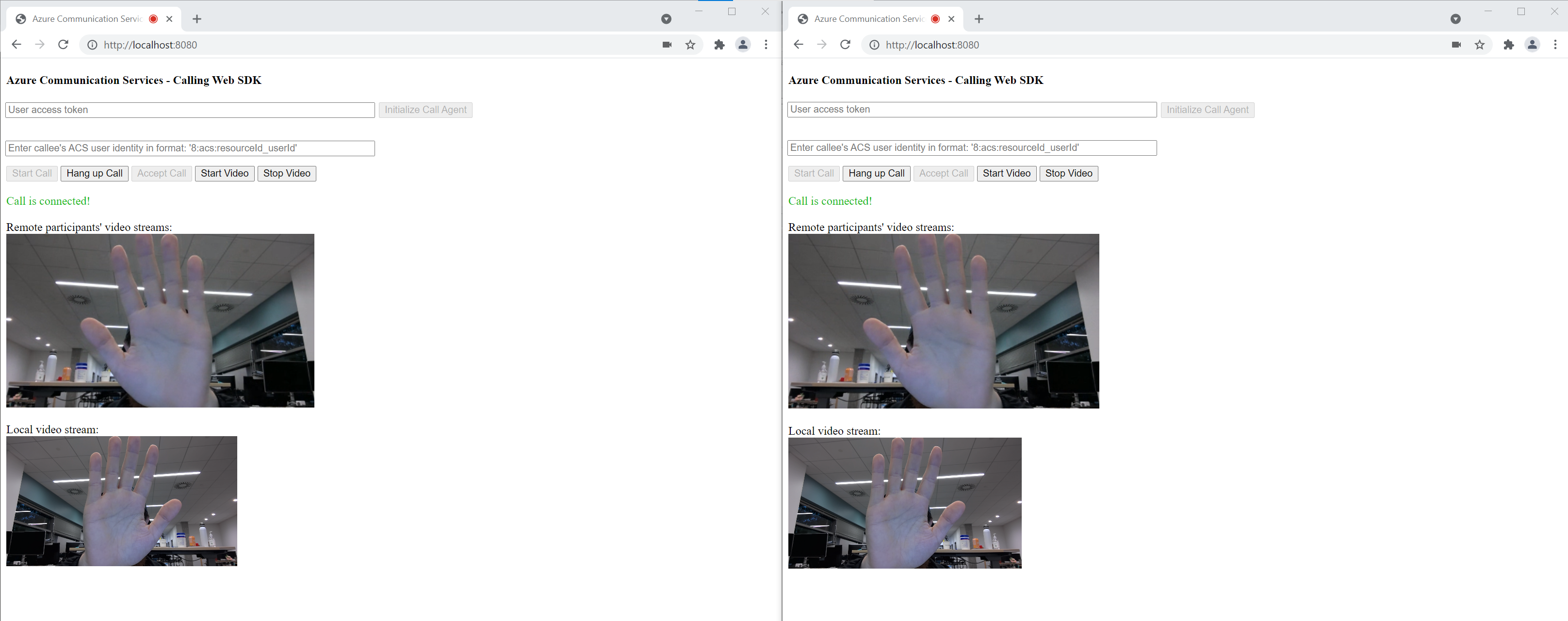
這兩個索引標籤現在已成功處於 1 對 1 個視訊通話中。 這兩個使用者可以聽到彼此的音訊,並看見彼此的視訊串流。
使用通訊服務的通話 SDK,在應用程式中新增 1 對 1 音訊和視訊通話,以開始使用 Azure 通訊服務。 您將了解如何使用適用於 Windows 的 Azure 通訊服務通話 SDK,開始並接聽通話。
範例程式碼
如果您想要直接跳到結尾,您可以在 GitHub \(英文\) 上下載此快速入門作為範例。
必要條件
若要完成本教學課程,您需要下列必要條件:
- 具有有效訂用帳戶的 Azure 帳戶。 免費建立帳戶。
- 安裝包含通用 Windows 平台開發工作負載的 Visual Studio 2022。
- 已部署通訊服務資源。 建立通訊服務資源。 您必須針對此快速入門記錄您的連接字串。
- 針對您的 Azure 通訊服務的使用者存取權杖。
- 使用 Graph 總管取得 Teams 執行緒識別碼來進行通話作業。 深入了解如何建立聊天對話識別碼。
設定
建立專案
在 Visual Studio 中,使用 [空白應用程式 (通用 Windows)] 範本建立新專案,以設定單頁通用 Windows 平台 (UWP) 應用程式。
![螢幕擷取畫面:顯示 Visual Studio 內的 [新 UWP 專案] 視窗。](media/windows/create-a-new-project.png)
Install the package
以滑鼠右鍵選取您的專案,然後移至 Manage Nuget Packages 以安裝 Azure.Communication.Calling.WindowsClient1.2.0-beta.1 或更高版本。 請確定已選取 [包含發行前版本]。
要求存取
移至 Package.appxmanifest 並選取 Capabilities。
勾選 Internet (Client) 和 Internet (Client & Server) 以取得網際網路的輸入和輸出存取權。 勾選 Microphone 以存取麥克風的音訊來源,並勾選 Webcam 以存取相機的視訊來源。
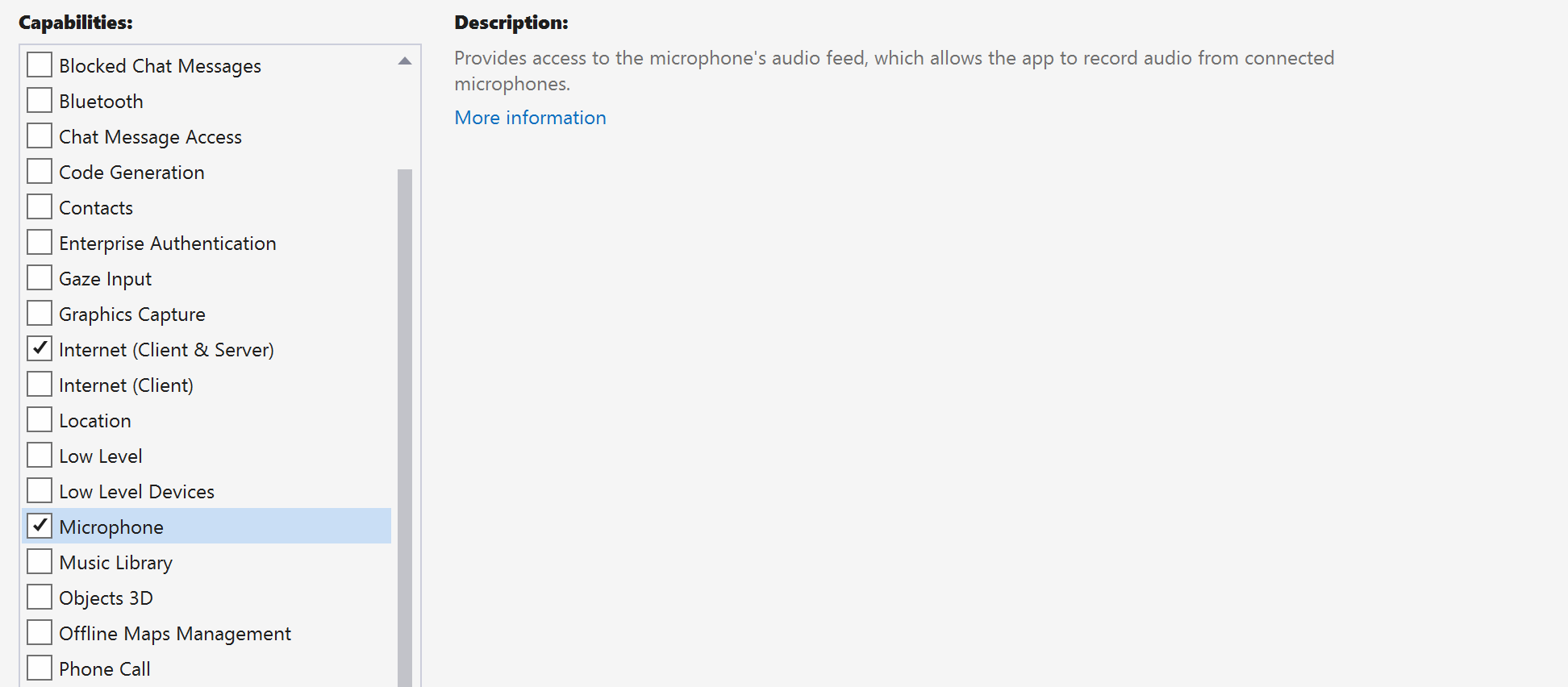
設定應用程式架構
我們必須設定基本配置來附加邏輯。 為了撥打外撥電話,我們需要 TextBox 來提供被通話者的使用者識別碼。 我們也需要 [Start/Join call] 按鈕和 [Hang up] 按鈕。 此範例中也包含 Mute 和 BackgroundBlur 核取方塊,用於示範切換音訊狀態和視訊效果的功能。
開啟專案的 MainPage.xaml,並將 Grid 節點新增至 Page:
<Page
x:Class="CallingQuickstart.MainPage"
xmlns="http://schemas.microsoft.com/winfx/2006/xaml/presentation"
xmlns:x="http://schemas.microsoft.com/winfx/2006/xaml"
xmlns:local="using:CallingQuickstart"
xmlns:d="http://schemas.microsoft.com/expression/blend/2008"
xmlns:mc="http://schemas.openxmlformats.org/markup-compatibility/2006"
mc:Ignorable="d"
Background="{ThemeResource ApplicationPageBackgroundThemeBrush}" Width="800" Height="600">
<Grid>
<Grid.RowDefinitions>
<RowDefinition Height="16*"/>
<RowDefinition Height="30*"/>
<RowDefinition Height="200*"/>
<RowDefinition Height="60*"/>
<RowDefinition Height="16*"/>
</Grid.RowDefinitions>
<TextBox Grid.Row="1" x:Name="CalleeTextBox" PlaceholderText="Who would you like to call?" TextWrapping="Wrap" VerticalAlignment="Center" Height="30" Margin="10,10,10,10" />
<Grid x:Name="AppTitleBar" Background="LightSeaGreen">
<TextBlock x:Name="QuickstartTitle" Text="Calling Quickstart sample title bar" Style="{StaticResource CaptionTextBlockStyle}" Padding="7,7,0,0"/>
</Grid>
<Grid Grid.Row="2">
<Grid.RowDefinitions>
<RowDefinition/>
</Grid.RowDefinitions>
<Grid.ColumnDefinitions>
<ColumnDefinition Width="*"/>
<ColumnDefinition Width="*"/>
</Grid.ColumnDefinitions>
<MediaPlayerElement x:Name="LocalVideo" HorizontalAlignment="Center" Stretch="UniformToFill" Grid.Column="0" VerticalAlignment="Center" AutoPlay="True" />
<MediaPlayerElement x:Name="RemoteVideo" HorizontalAlignment="Center" Stretch="UniformToFill" Grid.Column="1" VerticalAlignment="Center" AutoPlay="True" />
</Grid>
<StackPanel Grid.Row="3" Orientation="Vertical" Grid.RowSpan="2">
<StackPanel Orientation="Horizontal">
<Button x:Name="CallButton" Content="Start/Join call" Click="CallButton_Click" VerticalAlignment="Center" Margin="10,0,0,0" Height="40" Width="123"/>
<Button x:Name="HangupButton" Content="Hang up" Click="HangupButton_Click" VerticalAlignment="Center" Margin="10,0,0,0" Height="40" Width="123"/>
<CheckBox x:Name="MuteLocal" Content="Mute" Margin="10,0,0,0" Click="MuteLocal_Click" Width="74"/>
</StackPanel>
</StackPanel>
<TextBox Grid.Row="5" x:Name="Stats" Text="" TextWrapping="Wrap" VerticalAlignment="Center" Height="30" Margin="0,2,0,0" BorderThickness="2" IsReadOnly="True" Foreground="LightSlateGray" />
</Grid>
</Page>
開啟 MainPage.xaml.cs 並將內容取代為下列實作:
using Azure.Communication.Calling.WindowsClient;
using System;
using System.Collections.Generic;
using System.ComponentModel;
using System.Linq;
using System.Threading.Tasks;
using Windows.ApplicationModel;
using Windows.ApplicationModel.Core;
using Windows.Media.Core;
using Windows.Networking.PushNotifications;
using Windows.UI;
using Windows.UI.ViewManagement;
using Windows.UI.Xaml;
using Windows.UI.Xaml.Controls;
using Windows.UI.Xaml.Media;
using Windows.UI.Xaml.Navigation;
namespace CallingQuickstart
{
public sealed partial class MainPage : Page
{
private const string authToken = "<AUTHENTICATION_TOKEN>";
private CallClient callClient;
private CallTokenRefreshOptions callTokenRefreshOptions = new CallTokenRefreshOptions(false);
private TeamsCallAgent teamsCallAgent;
private TeamsCommunicationCall teamsCall;
private LocalOutgoingAudioStream micStream;
private LocalOutgoingVideoStream cameraStream;
#region Page initialization
public MainPage()
{
this.InitializeComponent();
// Additional UI customization code goes here
}
protected override async void OnNavigatedTo(NavigationEventArgs e)
{
base.OnNavigatedTo(e);
}
#endregion
#region UI event handlers
private async void CallButton_Click(object sender, RoutedEventArgs e)
{
// Start a call
}
private async void HangupButton_Click(object sender, RoutedEventArgs e)
{
// Hang up a call
}
private async void MuteLocal_Click(object sender, RoutedEventArgs e)
{
// Toggle mute/unmute audio state of a call
}
#endregion
#region API event handlers
private async void OnIncomingCallAsync(object sender, TeamsIncomingCallReceivedEventArgs args)
{
// Handle incoming call event
}
private async void OnStateChangedAsync(object sender, PropertyChangedEventArgs args)
{
// Handle connected and disconnected state change of a call
}
#endregion
}
}
物件模型
下方列出類別和介面的表格會處理 Azure 通訊服務通話 SDK 的一些主要功能:
| 名稱 | 描述 |
|---|---|
CallClient |
CallClient 是通話 SDK 的主要進入點。 |
TeamsCallAgent |
TeamsCallAgent 可用來開始和管理通話。 |
TeamsCommunicationCall |
TeamsCommunicationCall 可用來管理進行中的通話。 |
CallTokenCredential |
CallTokenCredential 可作為權杖認證用來將 TeamsCallAgent 具現化。 |
CallIdentifier |
CallIdentifier 可用來代表使用者的身分識別,其可以是下列其中一個選項:MicrosoftTeamsUserCallIdentifier、UserCallIdentifier、PhoneNumberCallIdentifier 等。 |
驗證用戶端
透過使用者存取權杖來將 TeamsCallAgent 執行個體初始化,此存取權杖可讓我們撥打和接聽通話,並選擇性地取得 DeviceManager 執行個體來查詢用戶端裝置設定。
在程式碼中,將 <AUTHENTICATION_TOKEN> 取代為使用者存取權杖。 如果您還沒有可用的權杖,請參閱使用者存取權杖文件。
新增 InitCallAgentAndDeviceManagerAsync 函式,以啟動 SDK。 您可以自訂此協助程式,以符合應用程式的需求。
private async Task InitCallAgentAndDeviceManagerAsync()
{
this.callClient = new CallClient(new CallClientOptions() {
Diagnostics = new CallDiagnosticsOptions() {
AppName = "CallingQuickstart",
AppVersion="1.0",
Tags = new[] { "Calling", "CTE", "Windows" }
}
});
// Set up local video stream using the first camera enumerated
var deviceManager = await this.callClient.GetDeviceManagerAsync();
var camera = deviceManager?.Cameras?.FirstOrDefault();
var mic = deviceManager?.Microphones?.FirstOrDefault();
micStream = new LocalOutgoingAudioStream();
var tokenCredential = new CallTokenCredential(authToken, callTokenRefreshOptions);
this.teamsCallAgent = await this.callClient.CreateTeamsCallAgentAsync(tokenCredential);
this.teamsCallAgent.IncomingCallReceived += OnIncomingCallAsync;
}
開始通話
將實作新增至 CallButton_Click 以使用我們建立的 teamsCallAgent 物件啟動各種通話,並關聯 TeamsCommunicationCall 物件上的 RemoteParticipantsUpdated 和 StateChanged 事件處理常式。
private async void CallButton_Click(object sender, RoutedEventArgs e)
{
var callString = CalleeTextBox.Text.Trim();
teamsCall = await StartCteCallAsync(callString);
if (teamsCall != null)
{
teamsCall.StateChanged += OnStateChangedAsync;
}
}
結束通話
按兩下 [Hang up] 按鈕時,結束目前的通話。 將實作新增至 HangupButton_Click 以結束通話,並停止預覽和視訊串流。
private async void HangupButton_Click(object sender, RoutedEventArgs e)
{
var teamsCall = this.teamsCallAgent?.Calls?.FirstOrDefault();
if (teamsCall != null)
{
await teamsCall.HangUpAsync(new HangUpOptions() { ForEveryone = false });
}
}
在音訊上切換靜音/取消靜音
按兩下 [Mute] 按鈕時,可將傳出音訊設為靜音。 將實作新增至 MuteLocal_Click 以將通話設為靜音。
private async void MuteLocal_Click(object sender, RoutedEventArgs e)
{
var muteCheckbox = sender as CheckBox;
if (muteCheckbox != null)
{
var teamsCall = this.teamsCallAgent?.Calls?.FirstOrDefault();
if (teamsCall != null)
{
if ((bool)muteCheckbox.IsChecked)
{
await teamsCall.MuteOutgoingAudioAsync();
}
else
{
await teamsCall.UnmuteOutgoingAudioAsync();
}
}
// Update the UI to reflect the state
}
}
啟動呼叫
取得 StartTeamsCallOptions 物件之後,即可使用 TeamsCallAgent 來起始 Teams 通話:
private async Task<TeamsCommunicationCall> StartCteCallAsync(string cteCallee)
{
var options = new StartTeamsCallOptions();
var teamsCall = await this.teamsCallAgent.StartCallAsync( new MicrosoftTeamsUserCallIdentifier(cteCallee), options);
return call;
}
接聽來電
TeamsIncomingCallReceived 事件接收設定於 SDK 啟動程序協助程式 InitCallAgentAndDeviceManagerAsync 中。
this.teamsCallAgent.IncomingCallReceived += OnIncomingCallAsync;
應用程式有機會設定應如何接受來電,例如,視訊和音訊串流類型。
private async void OnIncomingCallAsync(object sender, TeamsIncomingCallReceivedEventArgs args)
{
var teamsIncomingCall = args.IncomingCall;
var acceptteamsCallOptions = new AcceptTeamsCallOptions() { };
teamsCall = await teamsIncomingCall.AcceptAsync(acceptteamsCallOptions);
teamsCall.StateChanged += OnStateChangedAsync;
}
加入 Teams 通話
使用者也可以藉由傳遞連結來加入現有的通話
TeamsMeetingLinkLocator link = new TeamsMeetingLinkLocator("meetingLink");
JoinTeamsCallOptions options = new JoinTeamsCallOptions();
TeamsCall call = await teamsCallAgent.JoinAsync(link, options);
監視和回應通話狀態變更事件
當進行中的通話從一種狀態異動為另一種狀態時,就會引發 TeamsCommunicationCall 物件上的 StateChanged 事件。 應用程式有機會反映 UI 上的狀態變更,或插入商務邏輯。
private async void OnStateChangedAsync(object sender, PropertyChangedEventArgs args)
{
var teamsCall = sender as TeamsCommunicationCall;
if (teamsCall != null)
{
var state = teamsCall.State;
// Update the UI
switch (state)
{
case CallState.Connected:
{
await teamsCall.StartAudioAsync(micStream);
break;
}
case CallState.Disconnected:
{
teamsCall.StateChanged -= OnStateChangedAsync;
teamsCall.Dispose();
break;
}
default: break;
}
}
}
執行程式碼
在 Visual Studio 中,您可以建置並執行程式碼。 針對解決方案平台,我們支援 ARM64、x64 和 x86。
您可以在文字欄位中提供使用者識別碼,並按一下 [Start Call/Join] 按鈕以向外撥打通話。 呼叫 8:echo123,會將您連線到回應聊天機器人,此功能非常適合入門,以及驗證您的音訊裝置運作正常。
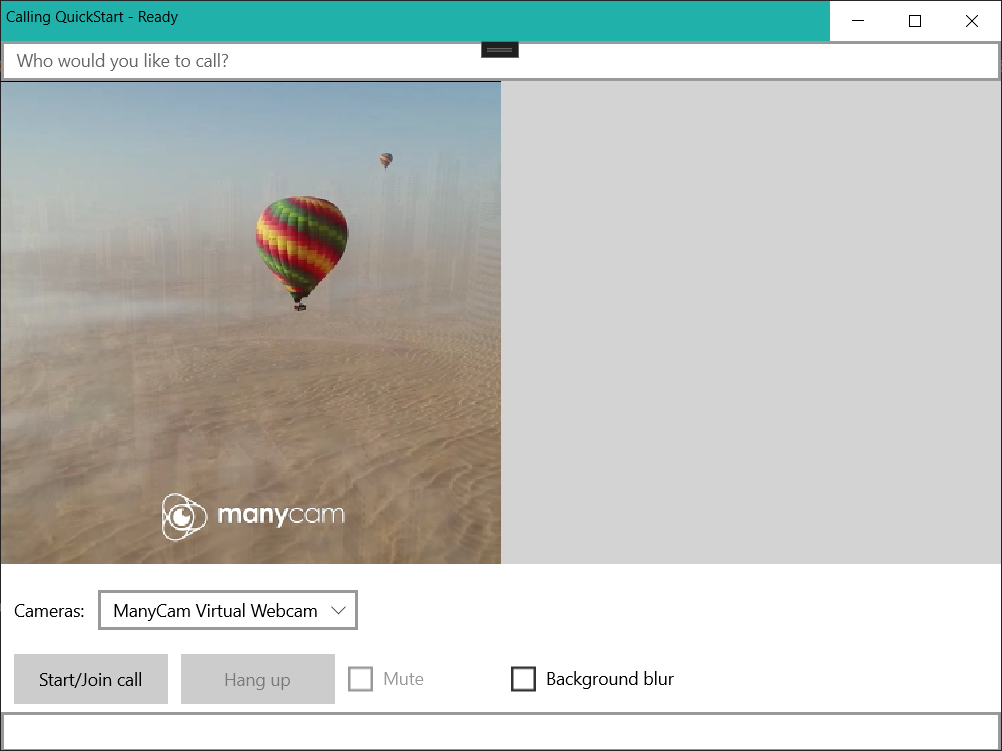
使用通訊服務的通話 SDK,在應用程式中新增 1 對 1 音訊和視訊通話,以開始使用 Azure 通訊服務。 您將了解如何使用適用於 Java 的 Azure 通訊服務通話 SDK,開始並接聽通話。
範例程式碼
如果您想要直接跳到結尾,您可以在 GitHub \(英文\) 上下載此快速入門作為範例。
必要條件
- 具有有效訂用帳戶的 Azure 帳戶。 免費建立帳戶。
- Android Studio,用於建立 Android 應用程式。
- 已部署通訊服務資源。 建立通訊服務資源。 您必須針對此快速入門記錄您的連接字串。
- 針對您的 Azure 通訊服務的使用者存取權杖。
- 使用 Graph 總管取得 Teams 執行緒識別碼來進行通話作業。 深入了解如何建立聊天對話識別碼。
設定
建立具有空白活動的 Android 應用程式
從 Android Studio 中,選取 [啟動新的 Android Studio 專案]。
![顯示在 Android Studio 中選取 [啟動新的 Android Studio 專案] 按鈕的螢幕擷取畫面。](media/android/studio-new-project.png)
選取 [手機和平板電腦] 底下的 [空白活動] 專案範本。
![顯示在 [專案範本] 畫面中選取 [空白活動] 選項的螢幕擷取畫面。](media/android/studio-blank-activity.png)
針對最低 SDK 選取 [API 26:Android 8.0(Oreo)] 或更新版本。
![顯示在 [專案範本] 畫面 2 中選取 [空白活動] 選項的螢幕擷取畫面。](media/android/studio-calling-min-api.png)
Install the package
找出您的專案層級 build.gradle,並務必將 mavenCentral() 新增至 buildscript 和 allprojects 下的存放庫清單
buildscript {
repositories {
...
mavenCentral()
...
}
}
allprojects {
repositories {
...
mavenCentral()
...
}
}
然後,在您的模組層級 build.gradle 中,將以下幾行新增至相依性和 android 區段
android {
...
packagingOptions {
pickFirst 'META-INF/*'
}
compileOptions {
sourceCompatibility JavaVersion.VERSION_1_8
targetCompatibility JavaVersion.VERSION_1_8
}
}
dependencies {
...
implementation 'com.azure.android:azure-communication-calling:1.0.0-beta.8'
...
}
將權限新增至應用程式資訊清單
為了要求進行通話所需的權限,必須在應用程式資訊清單 (app/src/main/AndroidManifest.xml) 中宣告。 使用下列程式碼取代檔案的內容:
<?xml version="1.0" encoding="utf-8"?>
<manifest xmlns:android="http://schemas.android.com/apk/res/android"
package="com.contoso.ctequickstart">
<uses-permission android:name="android.permission.INTERNET" />
<uses-permission android:name="android.permission.ACCESS_NETWORK_STATE" />
<uses-permission android:name="android.permission.ACCESS_WIFI_STATE" />
<uses-permission android:name="android.permission.RECORD_AUDIO" />
<uses-permission android:name="android.permission.CAMERA" />
<uses-permission android:name="android.permission.WRITE_EXTERNAL_STORAGE" />
<uses-permission android:name="android.permission.READ_PHONE_STATE" />
<application
android:allowBackup="true"
android:icon="@mipmap/ic_launcher"
android:label="@string/app_name"
android:roundIcon="@mipmap/ic_launcher_round"
android:supportsRtl="true"
android:theme="@style/AppTheme">
<!--Our Calling SDK depends on the Apache HTTP SDK.
When targeting Android SDK 28+, this library needs to be explicitly referenced.
See https://developer.android.com/about/versions/pie/android-9.0-changes-28#apache-p-->
<uses-library android:name="org.apache.http.legacy" android:required="false"/>
<activity android:name=".MainActivity">
<intent-filter>
<action android:name="android.intent.action.MAIN" />
<category android:name="android.intent.category.LAUNCHER" />
</intent-filter>
</activity>
</application>
</manifest>
設定應用程式的配置
需要兩個輸入:被呼叫者識別碼的文字輸入,以及用來進行呼叫的按鈕。 這些輸入可以透過設計工具或藉由編輯版面配置 xml 來新增。 建立識別碼為 call_button、文字輸入為 callee_id 的按鈕。 瀏覽至 app/src/main/res/layout/activity_main.xml 並且以下列程式碼取代檔案的內容:
<?xml version="1.0" encoding="utf-8"?>
<androidx.constraintlayout.widget.ConstraintLayout xmlns:android="http://schemas.android.com/apk/res/android"
xmlns:app="http://schemas.android.com/apk/res-auto"
xmlns:tools="http://schemas.android.com/tools"
android:layout_width="match_parent"
android:layout_height="match_parent"
tools:context=".MainActivity">
<Button
android:id="@+id/call_button"
android:layout_width="wrap_content"
android:layout_height="wrap_content"
android:layout_marginBottom="16dp"
android:text="Call"
app:layout_constraintBottom_toBottomOf="parent"
app:layout_constraintEnd_toEndOf="parent"
app:layout_constraintStart_toStartOf="parent" />
<EditText
android:id="@+id/callee_id"
android:layout_width="wrap_content"
android:layout_height="wrap_content"
android:ems="10"
android:hint="Callee Id"
android:inputType="textPersonName"
app:layout_constraintBottom_toTopOf="@+id/call_button"
app:layout_constraintEnd_toEndOf="parent"
app:layout_constraintStart_toStartOf="parent"
app:layout_constraintTop_toTopOf="parent" />
</androidx.constraintlayout.widget.ConstraintLayout>
建立主要活動 Scaffolding 和繫結
建立版面配置之後,即可新增繫結,以及活動的基本 Scaffolding。 活動會處理要求執行階段權限、建立小組通話代理程式,並且在按下按鈕時進行通話。 每個項目都涵蓋在自己的區段中。 系統會覆寫 onCreate 方法以叫用 getAllPermissions 和 createTeamsAgent,並新增呼叫按鈕的繫結。 此事件只會在建立活動時發生一次。 如需 onCreate 的詳細資訊,請參閱了解活動生命週期指南。
瀏覽至 MainActivity.java,然後以下列程式碼取代內容:
package com.contoso.ctequickstart;
import androidx.appcompat.app.AppCompatActivity;
import androidx.core.app.ActivityCompat;
import android.media.AudioManager;
import android.Manifest;
import android.content.pm.PackageManager;
import android.os.Bundle;
import android.widget.Button;
import android.widget.EditText;
import android.widget.Toast;
import com.azure.android.communication.common.CommunicationUserIdentifier;
import com.azure.android.communication.common.CommunicationTokenCredential;
import com.azure.android.communication.calling.TeamsCallAgent;
import com.azure.android.communication.calling.CallClient;
import com.azure.android.communication.calling.StartTeamsCallOptions;
import java.util.ArrayList;
public class MainActivity extends AppCompatActivity {
private TeamsCallAgent teamsCallAgent;
@Override
protected void onCreate(Bundle savedInstanceState) {
super.onCreate(savedInstanceState);
setContentView(R.layout.activity_main);
getAllPermissions();
createTeamsAgent();
// Bind call button to call `startCall`
Button callButton = findViewById(R.id.call_button);
callButton.setOnClickListener(l -> startCall());
setVolumeControlStream(AudioManager.STREAM_VOICE_CALL);
}
/**
* Request each required permission if the app doesn't already have it.
*/
private void getAllPermissions() {
// See section on requesting permissions
}
/**
* Create the call agent for placing calls
*/
private void createTeamsAgent() {
// See section on creating the call agent
}
/**
* Place a call to the callee id provided in `callee_id` text input.
*/
private void startCall() {
// See section on starting the call
}
}
要求執行階段時的權限
針對 Android 6.0 和更新版本 (API 層級 23) 和 targetSdkVersion 23 或更新版本,權限會在執行階段授與,而不是在安裝應用程式時。 為了提供支援,可實作 getAllPermissions 來呼叫 ActivityCompat.checkSelfPermission 和 ActivityCompat.requestPermissions,以取得每個必要的權限。
/**
* Request each required permission if the app doesn't already have it.
*/
private void getAllPermissions() {
String[] requiredPermissions = new String[]{Manifest.permission.RECORD_AUDIO, Manifest.permission.CAMERA, Manifest.permission.WRITE_EXTERNAL_STORAGE, Manifest.permission.READ_PHONE_STATE};
ArrayList<String> permissionsToAskFor = new ArrayList<>();
for (String permission : requiredPermissions) {
if (ActivityCompat.checkSelfPermission(this, permission) != PackageManager.PERMISSION_GRANTED) {
permissionsToAskFor.add(permission);
}
}
if (!permissionsToAskFor.isEmpty()) {
ActivityCompat.requestPermissions(this, permissionsToAskFor.toArray(new String[0]), 1);
}
}
注意
在設計您的應用程式時,請考量何時應要求這些權限。 您應該視需要要求權限,而不是提前要求。 如需詳細資訊,請參閱 Android 權限指南 \(機器翻譯\)。
物件模型
下列類別和介面會處理 Azure 通訊服務通話 SDK 的一些重大功能:
| 名稱 | 描述 |
|---|---|
CallClient |
CallClient 是通話 SDK 的主要進入點。 |
TeamsCallAgent |
TeamsCallAgent 可用來開始和管理通話。 |
TeamsCall |
TeamsCall 用來表示 Teams 通話。 |
CommunicationTokenCredential |
CommunicationTokenCredential 可作為權杖認證用來將 TeamsCallAgent 具現化。 |
CommunicationIdentifier |
CommunicationIdentifier 會當成可參與通話的不同參與者類型。 |
從使用者存取權杖建立代理程式
透過使用者權杖,可以將已驗證的呼叫代理程式具現化。 一般來說,此權杖會從具有應用程式特定驗證的服務產生。 如需使用者存取權杖的詳細資訊,請參閱使用者存取權杖指南。
在快速入門中,將 <User_Access_Token> 取代為針對您的 Azure 通訊服務資源所產生的使用者存取權杖。
/**
* Create the teams call agent for placing calls
*/
private void createAgent() {
String userToken = "<User_Access_Token>";
try {
CommunicationTokenCredential credential = new CommunicationTokenCredential(userToken);
teamsCallAgent = new CallClient().createTeamsCallAgent(getApplicationContext(), credential).get();
} catch (Exception ex) {
Toast.makeText(getApplicationContext(), "Failed to create teams call agent.", Toast.LENGTH_SHORT).show();
}
}
使用呼叫代理程式開始通話
您可以透過小組呼叫代理程式來進行呼叫,只需要提供被呼叫者識別碼和呼叫選項的清單。 在快速入門中,會使用沒有視訊的預設呼叫選項,以及文字輸入中的單一被呼叫者識別碼。
/**
* Place a call to the callee id provided in `callee_id` text input.
*/
private void startCall() {
EditText calleeIdView = findViewById(R.id.callee_id);
String calleeId = calleeIdView.getText().toString();
StartTeamsCallOptions options = new StartTeamsCallOptions();
teamsCallAgent.startCall(
getApplicationContext(),
new MicrosoftTeamsUserCallIdentifier(calleeId),
options);
}
接聽電話
使用小組通話代理程式,只使用目前內容的參考,即可接受通話。
public void acceptACall(TeamsIncomingCall teamsIncomingCall){
teamsIncomingCall.accept(this);
}
加入 Teams 通話
使用者也可以藉由傳遞連結來加入現有的通話。
/**
* Join a call using a teams meeting link.
*/
public TeamsCall joinTeamsCall(TeamsCallAgent teamsCallAgent){
TeamsMeetingLinkLocator link = new TeamsMeetingLinkLocator("meetingLink");
TeamsCall call = teamsCallAgent.join(this, link);
}
使用選項加入 Teams 通話
我們也可以使用預設選項 (例如靜音) 加入現有通話。
/**
* Join a call using a teams meeting link while muted.
*/
public TeamsCall joinTeamsCall(TeamsCallAgent teamsCallAgent){
TeamsMeetingLinkLocator link = new TeamsMeetingLinkLocator("meetingLink");
OutgoingAudioOptions audioOptions = new OutgoingAudioOptions().setMuted(true);
JoinTeamsCallOptions options = new JoinTeamsCallOptions().setAudioOptions(audioOptions);
TeamsCall call = teamsCallAgent.join(this, link, options);
}
設定來電接聽程式
若要能夠偵測來電和不是該使用者完成的其他動作,必須設定接聽程式。
private TeamsIncomingCall teamsincomingCall;
teamsCallAgent.addOnIncomingCallListener(this::handleIncomingCall);
private void handleIncomingCall(TeamsIncomingCall incomingCall) {
this.teamsincomingCall = incomingCall;
}
啟動應用程式並呼叫 Echo Bot
應用程式現在可以使用工具列上的 [執行應用程式] 按鈕 (Shift+F10) 來啟動。 確認您可以藉由呼叫 8:echo123 來進行通話。 系統會播放預先錄製的訊息,然後為您重複訊息。
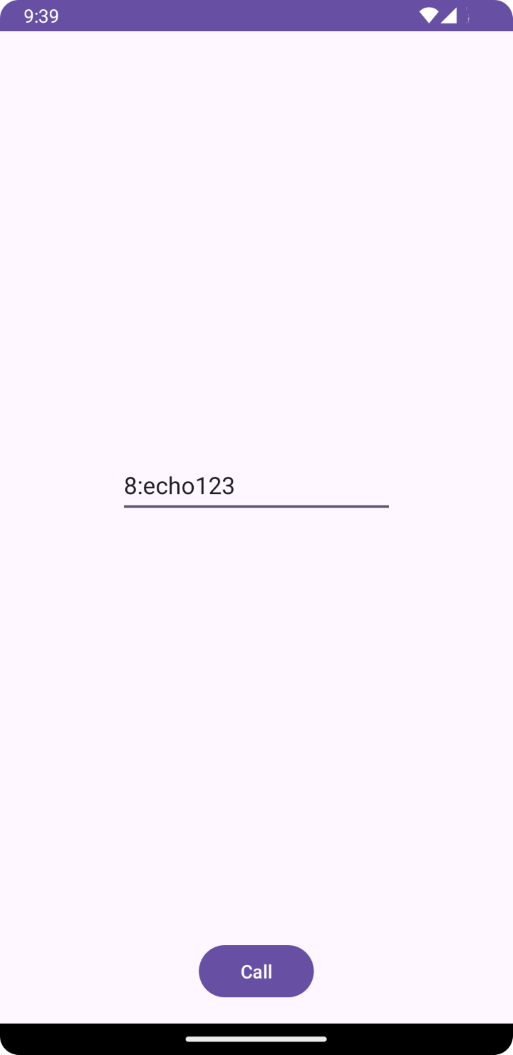
使用通訊服務的通話 SDK,在您的應用程式中新增一對一視訊通話,以開始使用 Azure 通訊服務。 您將了解如何使用適用於 iOS 的 Azure 通訊服務通話 SDK,使用 Teams 身分識別開始並接聽視訊通話。
範例程式碼
如果您想要直接跳到結尾,您可以在 GitHub \(英文\) 上下載此快速入門作為範例。
必要條件
- 取得具備有效訂用帳戶的 Azure 帳戶。 免費建立帳戶。
- 執行 Xcode 的 Mac,以及安裝在您 Keychain 中的有效開發人員憑證。
- 建立作用中的通訊服務資源。 建立通訊服務資源。 您必須針對此快速入門記錄您的連接字串。
- 針對您的 Azure 通訊服務的使用者存取權杖。
- 使用 Graph 總管取得 Teams 執行緒識別碼來進行通話作業。 深入了解如何建立聊天對話識別碼
設定
建立 XCode 專案
在 Xcode 中,建立新的 iOS 專案,並選取 [單一檢視應用程式] 範本。 此教學課程使用 SwiftUI 架構 \(英文\),因此,您應將 [語言] 設定為 [Swift],並將 [使用者介面] 設定為 [SwiftUI]。 進行本快速入門期間,您不會建立測試。 您可以視需要取消核取 [包含測試]。
![螢幕擷取畫面:顯示 Xcode 內的 [新增專案] 視窗。](media/ios/xcode-new-ios-project.png)
安裝 CocoaPods
使用此指南,在 Mac 上安裝 CocoaPods \(英文\)。
使用 CocoaPods 安裝套件和相依性
若要為應用程式建立
Podfile,請開啟終端,然後瀏覽至專案資料夾並執行 pod init。將下列程式碼新增至
Podfile並儲存。 請參閱 SDK 支援版本。
platform :ios, '13.0'
use_frameworks!
target 'VideoCallingQuickstart' do
pod 'AzureCommunicationCalling', '~> 2.10.0'
end
執行 pod install。
使用 Xcode 開啟
.xcworkspace。
要求存取麥克風和相機的權限
若要存取裝置的麥克風和相機,您必須以 NSMicrophoneUsageDescription 和 NSCameraUsageDescription 更新應用程式的資訊屬性清單。 您可以將相關聯的值設定為字串,其中包含系統用來向使用者要求存取權的對話。
以滑鼠右鍵按一下專案樹狀結構的 Info.plist 項目,然後選取 [開啟為] > [原始程式碼]。 將以下幾行新增至最上層 <dict> 區段中,然後儲存檔案。
<key>NSMicrophoneUsageDescription</key>
<string>Need microphone access for VOIP calling.</string>
<key>NSCameraUsageDescription</key>
<string>Need camera access for video calling</string>
設定應用程式架構
開啟專案的 ContentView.swift 檔案,並將匯入宣告新增至檔案頂端,以匯入 AzureCommunicationCalling 程式庫和 AVFoundation。 AVFoundation 可用於從程式碼擷取音訊權限。
import AzureCommunicationCalling
import AVFoundation
物件模型
下列類別和介面會處理適用於 iOS 的 Azure 通訊服務通話 SDK 的一些主要功能。
| 名稱 | 描述 |
|---|---|
CallClient |
CallClient 是通話 SDK 的主要進入點。 |
TeamsCallAgent |
TeamsCallAgent 可用來開始和管理通話。 |
TeamsIncomingCall |
TeamsIncomingCall 用來接受或拒絕來電。 |
CommunicationTokenCredential |
CommunicationTokenCredential 可作為權杖認證用來將 TeamsCallAgent 具現化。 |
CommunicationIdentifier |
CommunicationIdentifier 可用來代表使用者的身分識別,其可以是下列其中一個選項:CommunicationUserIdentifier、PhoneNumberIdentifier 或 CallingApplication。 |
建立 Teams 通話代理程式
使用一些簡單的 UI 控制項來取代 ContentView struct 的實作,讓使用者可以起始和結束通話。 在此快速入門中,我們會將商務邏輯附加至這些控制項。
struct ContentView: View {
@State var callee: String = ""
@State var callClient: CallClient?
@State var teamsCallAgent: TeamsCallAgent?
@State var teamsCall: TeamsCall?
@State var deviceManager: DeviceManager?
@State var localVideoStream:[LocalVideoStream]?
@State var teamsIncomingCall: TeamsIncomingCall?
@State var sendingVideo:Bool = false
@State var errorMessage:String = "Unknown"
@State var remoteVideoStreamData:[Int32:RemoteVideoStreamData] = [:]
@State var previewRenderer:VideoStreamRenderer? = nil
@State var previewView:RendererView? = nil
@State var remoteRenderer:VideoStreamRenderer? = nil
@State var remoteViews:[RendererView] = []
@State var remoteParticipant: RemoteParticipant?
@State var remoteVideoSize:String = "Unknown"
@State var isIncomingCall:Bool = false
@State var callObserver:CallObserver?
@State var remoteParticipantObserver:RemoteParticipantObserver?
var body: some View {
NavigationView {
ZStack{
Form {
Section {
TextField("Who would you like to call?", text: $callee)
Button(action: startCall) {
Text("Start Teams Call")
}.disabled(teamsCallAgent == nil)
Button(action: endCall) {
Text("End Teams Call")
}.disabled(teamsCall == nil)
Button(action: toggleLocalVideo) {
HStack {
Text(sendingVideo ? "Turn Off Video" : "Turn On Video")
}
}
}
}
// Show incoming call banner
if (isIncomingCall) {
HStack() {
VStack {
Text("Incoming call")
.padding(10)
.frame(maxWidth: .infinity, alignment: .topLeading)
}
Button(action: answerIncomingCall) {
HStack {
Text("Answer")
}
.frame(width:80)
.padding(.vertical, 10)
.background(Color(.green))
}
Button(action: declineIncomingCall) {
HStack {
Text("Decline")
}
.frame(width:80)
.padding(.vertical, 10)
.background(Color(.red))
}
}
.frame(maxWidth: .infinity, alignment: .topLeading)
.padding(10)
.background(Color.gray)
}
ZStack{
VStack{
ForEach(remoteViews, id:\.self) { renderer in
ZStack{
VStack{
RemoteVideoView(view: renderer)
.frame(width: .infinity, height: .infinity)
.background(Color(.lightGray))
}
}
Button(action: endCall) {
Text("End Call")
}.disabled(teamsCall == nil)
Button(action: toggleLocalVideo) {
HStack {
Text(sendingVideo ? "Turn Off Video" : "Turn On Video")
}
}
}
}.frame(maxWidth: .infinity, maxHeight: .infinity, alignment: .topLeading)
VStack{
if(sendingVideo)
{
VStack{
PreviewVideoStream(view: previewView!)
.frame(width: 135, height: 240)
.background(Color(.lightGray))
}
}
}.frame(maxWidth:.infinity, maxHeight:.infinity,alignment: .bottomTrailing)
}
}
.navigationBarTitle("Video Calling Quickstart")
}.onAppear{
// Authenticate the client
// Initialize the TeamsCallAgent and access Device Manager
// Ask for permissions
}
}
}
//Functions and Observers
struct PreviewVideoStream: UIViewRepresentable {
let view:RendererView
func makeUIView(context: Context) -> UIView {
return view
}
func updateUIView(_ uiView: UIView, context: Context) {}
}
struct RemoteVideoView: UIViewRepresentable {
let view:RendererView
func makeUIView(context: Context) -> UIView {
return view
}
func updateUIView(_ uiView: UIView, context: Context) {}
}
struct ContentView_Previews: PreviewProvider {
static var previews: some View {
ContentView()
}
}
驗證用戶端
為了將 TeamsCallAgent 執行個體初始化,您需要使用者存取權杖,才能撥打和接聽通話。 如果您沒有可用的權杖,請參閱使用者存取權杖文件。
當您具有權杖後,將下列程式碼新增至 ContentView.swift 中的 onAppear 回呼。 您必須將 <USER ACCESS TOKEN> 取代為資源的有效使用者存取權杖:
var userCredential: CommunicationTokenCredential?
do {
userCredential = try CommunicationTokenCredential(token: "<USER ACCESS TOKEN>")
} catch {
print("ERROR: It was not possible to create user credential.")
return
}
將 Teams CallAgent 初始化並存取裝置管理員
若要從 CallClient 建立 TeamsCallAgent 執行個體,使用 callClient.createTeamsCallAgent 方法,在 TeamsCallAgent 物件初始化後以非同步方式傳回該物件。
DeviceManager 可讓您列舉可於通話中用來傳輸音訊/視訊串流的本機裝置。 這也可讓您向使用者要求權限以存取麥克風/相機。
self.callClient = CallClient()
let options = TeamsCallAgentOptions()
// Enable CallKit in the SDK
options.callKitOptions = CallKitOptions(with: createCXProvideConfiguration())
self.callClient?.createTeamsCallAgent(userCredential: userCredential, options: options) { (agent, error) in
if error != nil {
print("ERROR: It was not possible to create a Teams call agent.")
return
} else {
self.teamsCallAgent = agent
print("Teams Call agent successfully created.")
self.teamsCallAgent!.delegate = teamsIncomingCallHandler
self.callClient?.getDeviceManager { (deviceManager, error) in
if (error == nil) {
print("Got device manager instance")
self.deviceManager = deviceManager
} else {
print("Failed to get device manager instance")
}
}
}
}
要求權限
我們需要將下列程式碼新增至 onAppear 回呼,以要求音訊和視訊的權限。
AVAudioSession.sharedInstance().requestRecordPermission { (granted) in
if granted {
AVCaptureDevice.requestAccess(for: .video) { (videoGranted) in
/* NO OPERATION */
}
}
}
撥出電話
startCall 方法會設定為點選 [開始通話] 按鈕時要執行的動作。 在此快速入門中,撥出的通話預設為僅限音訊。 若要透過視訊開始通話,則需要使用 LocalVideoStream 設定 VideoOptions,並使用 startCallOptions 傳遞它,以設定通話的初始選項。
let startTeamsCallOptions = StartTeamsCallOptions()
if sendingVideo {
if self.localVideoStream == nil {
self.localVideoStream = [LocalVideoStream]()
}
let videoOptions = VideoOptions(localVideoStreams: localVideoStream!)
startTeamsCallOptions.videoOptions = videoOptions
}
let callees: [CommunicationIdentifier] = [CommunicationUserIdentifier(self.callee)]
self.teamsCallAgent?.startCall(participants: callees, options: startTeamsCallOptions) { (call, error) in
// Handle call object if successful or an error.
}
加入 Teams 會議
join 方法可讓使用者加入小組會議。
let joinTeamsCallOptions = JoinTeamsCallOptions()
if sendingVideo
{
if self.localVideoStream == nil {
self.localVideoStream = [LocalVideoStream]()
}
let videoOptions = VideoOptions(localVideoStreams: localVideoStream!)
joinTeamsCallOptions.videoOptions = videoOptions
}
// Join the Teams meeting muted
if isMuted
{
let outgoingAudioOptions = OutgoingAudioOptions()
outgoingAudioOptions.muted = true
joinTeamsCallOptions.outgoingAudioOptions = outgoingAudioOptions
}
let teamsMeetingLinkLocator = TeamsMeetingLinkLocator(meetingLink: "https://meeting_link")
self.teamsCallAgent?.join(with: teamsMeetingLinkLocator, options: joinTeamsCallOptions) { (call, error) in
// Handle call object if successful or an error.
}
TeamsCallObserver 和 RemoteParticipantObserver 可用來管理通話中的事件和遠端參與者。 我們將在 setTeamsCallAndObserver 函式中設定觀察者。
func setTeamsCallAndObserver(call:TeamsCall, error:Error?) {
if (error == nil) {
self.teamsCall = call
self.teamsCallObserver = TeamsCallObserver(self)
self.teamsCall!.delegate = self.teamsCallObserver
// Attach a RemoteParticipant observer
self.remoteParticipantObserver = RemoteParticipantObserver(self)
} else {
print("Failed to get teams call object")
}
}
接聽來電
若要接聽來電,請實作 TeamsIncomingCallHandler 顯示來電橫幅,以便接聽或拒絕通話。 將下列實作放置於 TeamsIncomingCallHandler.swift 中。
final class TeamsIncomingCallHandler: NSObject, TeamsCallAgentDelegate, TeamsIncomingCallDelegate {
public var contentView: ContentView?
private var teamsIncomingCall: TeamsIncomingCall?
private static var instance: TeamsIncomingCallHandler?
static func getOrCreateInstance() -> TeamsIncomingCallHandler {
if let c = instance {
return c
}
instance = TeamsIncomingCallHandler()
return instance!
}
private override init() {}
func teamsCallAgent(_ teamsCallAgent: TeamsCallAgent, didReceiveIncomingCall incomingCall: TeamsIncomingCall) {
self.teamsIncomingCall = incomingCall
self.teamsIncomingCall.delegate = self
contentView?.showIncomingCallBanner(self.teamsIncomingCall!)
}
func teamsCallAgent(_ teamsCallAgent: TeamsCallAgent, didUpdateCalls args: TeamsCallsUpdatedEventArgs) {
if let removedCall = args.removedCalls.first {
contentView?.callRemoved(removedCall)
self.teamsIncomingCall = nil
}
}
}
我們需要將下列程式碼新增至 ContentView.swift 中的 onAppear 回呼,以建立 TeamsIncomingCallHandler 的執行個體:
成功建立 TeamsCallAgent 後,將委派設定為 TeamsCallAgent:
self.teamsCallAgent!.delegate = incomingCallHandler
一旦有來電,TeamsIncomingCallHandler 就會呼叫 showIncomingCallBanner 函式,以顯示 answer 和 decline 按鈕。
func showIncomingCallBanner(_ incomingCall: TeamsIncomingCall) {
self.teamsIncomingCall = incomingCall
}
附加至 answer 和 decline 的動作會以下列程式碼來實作。 為了透過視訊接聽通話,需要開啟本機視訊,並使用 localVideoStream 設定 AcceptCallOptions 選項。
func answerIncomingCall() {
let options = AcceptTeamsCallOptions()
guard let teamsIncomingCall = self.teamsIncomingCall else {
print("No active incoming call")
return
}
guard let deviceManager = deviceManager else {
print("No device manager instance")
return
}
if self.localVideoStreams == nil {
self.localVideoStreams = [LocalVideoStream]()
}
if sendingVideo
{
guard let camera = deviceManager.cameras.first else {
// Handle failure
return
}
self.localVideoStreams?.append( LocalVideoStream(camera: camera))
let videoOptions = VideoOptions(localVideoStreams: localVideosStreams!)
options.videoOptions = videoOptions
}
teamsIncomingCall.accept(options: options) { (call, error) in
// Handle call object if successful or an error.
}
}
func declineIncomingCall() {
self.teamsIncomingCall?.reject { (error) in
// Handle if rejection was successfully or not.
}
}
訂閱事件
我們可以實作 TeamsCallObserver 類別以訂閱事件集合,當值在通話期間變更時收到通知。
public class TeamsCallObserver: NSObject, TeamsCallDelegate, TeamsIncomingCallDelegate {
private var owner: ContentView
init(_ view:ContentView) {
owner = view
}
public func teamsCall(_ teamsCall: TeamsCall, didChangeState args: PropertyChangedEventArgs) {
if(teamsCall.state == CallState.connected) {
initialCallParticipant()
}
}
// render remote video streams when remote participant changes
public func teamsCall(_ teamsCall: TeamsCall, didUpdateRemoteParticipant args: ParticipantsUpdatedEventArgs) {
for participant in args.addedParticipants {
participant.delegate = self.remoteParticipantObserver
}
}
// Handle remote video streams when the call is connected
public func initialCallParticipant() {
for participant in owner.teamsCall.remoteParticipants {
participant.delegate = self.remoteParticipantObserver
for stream in participant.videoStreams {
renderRemoteStream(stream)
}
owner.remoteParticipant = participant
}
}
}
執行程式碼
您可以依序選取 [產品] > [執行] 或使用 (⌘-R) 鍵盤快速鍵,在 iOS 模擬器上建置並執行應用程式。
清除資源
如果您想要清除並移除通訊服務訂用帳戶,您可以刪除資源或資源群組。 刪除資源群組也會刪除與其相關聯的任何其他資源。 深入了解如何清除資源。
下一步
如需詳細資訊,請參閱下列文章:
![螢幕擷取畫面:顯示 Visual Studio 內的 [新 WinUI 專案] 視窗。](media/windows/create-a-new-winui-project.png)
